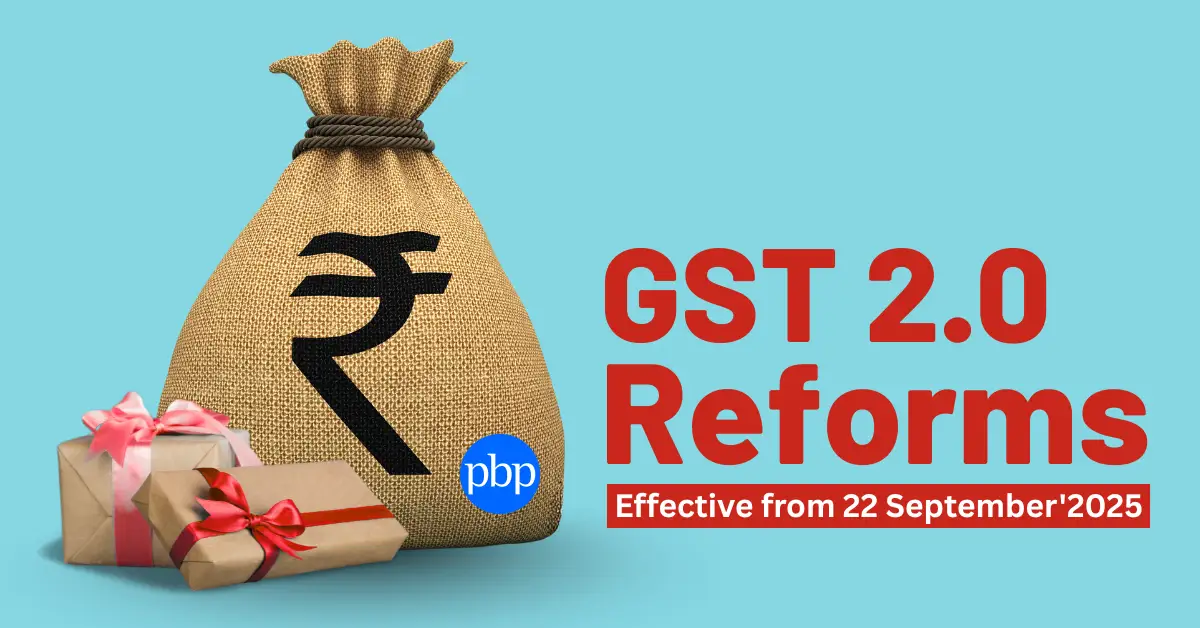This Diwali, India has unwrapped its biggest historic gift – the launch of GST 2.0! The Goods & Services Tax Council on 3rd September announced a two-tier rate structure. Effective September 22, the GST structure will have two slabs of taxes: 5 per cent and 18 per cent.
What are the GST Reforms
GST reforms refer to any sort of updates, changes, and improvements made to the Goods & Services Tax (GST) system to make it more simplified, fair, and transparent. GST reforms could be done in any form: tax slabs restructuring, correction of inverted duty structures, or alignment of tax as per the evolving economy needs.
Three Key Pillars of GST Reforms 2025
Structural Reforms
- Correction of Inverted Duty Structure
- Classification Issues Resolution
- Stability & Predictability
Rate Rationalisation:
- Less Tax on Essentials
- Two GST Slabs only – standard and merit
- Removal of Compensation Cess
Ease of Living
- Pre-filled GST returns facility
- Automated GST refund
What will get cheaper?
Health and Life Insurance Premium
The proposed GST exemption applies to all individual health insurance policies, including family floater plans, senior citizen covers, and related reinsurance services. Previously, these policies were subject to an 18% GST, which raised the premium amount significantly. For instance, a health policy with an annual premium of ₹10,000 effectively costs ₹11,800 after tax. With the GST rate now reduced to zero, the same policy will be available at its base price of ₹10,000. This move is expected to boost the appeal of life and health insurance, particularly among middle-class families and first-time buyers who often find premiums unaffordable
Drugs and Cancer medicines are likely to become cheaper
The GST 2.0 proposal is expected to prioritise healthcare. All medicines and drugs currently taxed at 12% are now expected to be taxed at 5%, aiming to reduce patients' financial burden. According to a CNBC TV 18 report, around 30 cancer medicines will become tax-free, along with certain life-saving drugs often used to treat rare diseases. Additionally, Iodine, Potassium iodate, and medical-grade oxygen are likely to benefit from a tax cut from 12% to 5%.
|
Items |
From |
To |
|
Thermometer |
12% |
5% |
|
Medical Grade Oxygen |
12% |
5% |
|
All Diagnostic Kits and Reagents |
12% |
5% |
|
Corrective Spectacles |
12% |
5% |
|
Glucometer & Test Strips |
12% |
5% |
Automobiles
If you are purchasing small cars (petrol engines under 1200cc, diesel engines under 1500cc, and length under 4 metres), the GST rate will be cut from 28% to 18%.
|
Items |
From |
To |
|
Petrol & Petrol Hybrid, LPG, CNG Cars (not exceeding 1200cc & 4000mm) |
28% |
18% |
|
Diesel & Diesel Hybrid Cars (not exceeding 1500cc & 4000mm) |
28% |
18% |
|
3-Wheeled Vehicles |
28% |
18% |
|
Motor Cycles (350cc & below) |
28% |
18% |
|
Motor Vehicles for Transport of Goods |
28% |
18% |
Affordable Education Items
|
Items |
From |
To |
|
Maps, Charts & Globes |
12% |
NIL |
|
Pencil, Sharpener, Crayons & Pastels |
12% |
NIL |
|
Exercise Books & Notebooks |
12% |
NIL |
|
Eraser |
5% |
NIL |
Daily Use Items
Durables like refrigerators, air conditioners, and washing machines will also get the benefit of lower GST rates. By minimum tax on commonly used and daily use items in the GST 2.0 reforms, the central government will aim at boosting consumption and improving compliance. This move will make a wide range of essentials more affordable.
|
Items |
From |
To |
|
Hair Oil, Shampoo, |
18% |
5% |
|
Butter, Ghee, Cheese & Dairy Spreads |
12% |
5% |
|
Toothpaste, Toilet Soap Bar, Tooth Brushes, Shaving Cream |
12% |
5% |
|
Pre-packaged Namkeens, Bhujia & Mixtures |
12% |
5% |
|
Feeding Bottles, Napkins for Babies & Clinical Diapers |
12% |
5% |
|
Sewing Machines |
12% |
5% |
Agriculture and Allied Sectors
GST moved from 12-18% to just 5% for fertilisers used in agriculture and allied sectors like bio-pesticides, micronutrients, and fertiliser acids, tractors, and their parts. Renewal energy devices like solar cookers and water heaters will also fall under lower GST tax rates.
|
Items |
From |
To |
|
Tractor Tyres & Parts |
18% |
5% |
|
Tractors |
12% |
5% |
|
Specified Bio-Pesticides, Micro-Nutrients |
12% |
5% |
|
Drip Irrigation System & Sprinklers |
12% |
5% |
|
Agricultural, Horticultural or Forestry Machines for Soil Preparation, Cultivation, Harvesting & Threshing |
12% |
5% |
Process Reforms
Registration
Automatic registration within 3 working days for applicants identified by the system based on data analysis. Who determines that he would not pass the Input Tax Credit exceeding ₹2.5 Lakh per month and opts for the Scheme.
Refund
Sanction of Provisional Refunds by a proper officer, through system-based risk evaluation for:
- Zero-Rated Supplies Supplies with Inverted Duty Structure
Bottom Line
For the year 2025, festive joy will not only be reflected in sweets, lights, or celebrations but also in a policy shift that will leave households with more breathing room. By minimizing the GST tax burdens on insurance premiums and daily essentials, the government has touched the lives in subtle but powerful ways.









